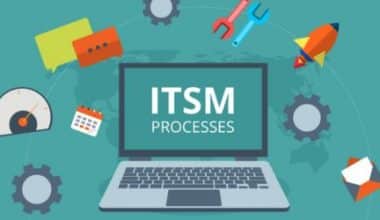Inventory management software is essential for building a method for tracking and controlling your inventory, particularly as your business grows. Here’s how inventory management software works, along with a look at the top 9 solutions on the market.
What Is Inventory Management?
The process of tracking all incoming and exiting supplies and items is known as inventory management. Almost all businesses that manufacture or sell items retain inventory on hand. Retail merchandise, for example, may be stored in a warehouse or shop by entrepreneurs. Manufacturers require materials for assembly and must trace product circulation from warehouses to stores or sellers.
Finally, restaurants track every shot of booze, food component, and paper product.
When Is Inventory Management Software Necessary?
Inventory software is useful for tracking several things or selling on multiple channels. Using a cloud-based application can save you time while also providing you with complete visibility into your ordering, shipping, and fulfillment operations.
A POS system with inventory features may be used in some retail stores or restaurants. However, manufacturers require software to oversee assembly, but e-commerce businesses must keep all channels up to date with real-time inventory counts.
Because they are concerned about their budget, small business owners are hesitant to invest in inventory software. However, even free services offer useful automation features that can save time and reduce sales losses.
How Much Does Inventory Management Software Cost?
Most inventory software is now cloud-based, and you pay a monthly or annual fee. Annual payments may be eligible for a 10% discount from software providers. Standalone inventory tools charge based on the quantity of orders, but POS systems with inventory features offer tiered plans with a broader range of functionality as you progress through the tiers.
Furthermore, programs may impose restrictions on the number of users, warehouses, and store locations. When adding more terminals, POS systems charge additional costs. Inventory management systems range in price from free to more than $300 per month. Higher-priced plans cater to businesses with big sales volumes and may include additional features such as enhanced analytics, integration, or automation tools.
What Are the Benefits of Inventory Management Software?
Installing and deploying inventory management software reduces the time spent tracking inventory you buy and sell. However, inventory management software offers various advantages to small business owners, including:
- Errors are reduced: Manual data entry is prone to errors. Inventory software allows you to scan barcodes and automatically update several sales channels.
- Increased efficiency: Automation tools perform monotonous activities in the background, allowing entrepreneurs to concentrate on more important issues.
- Optimized inventory: Keeping the correct stock balance is critical to your budget and customer experience. This procedure is visible thanks to the software.
- Higher profits: Accurate inventory management eliminates waste and aids in the detection of theft, while productivity enhancements allow you to do more without increasing personnel costs.
- Improved customer experience: When the buying and shipping processes are seamless and transparent, customers receive better service, which leads to more sales.
Best Inventory Management Software for Small Businesses
The best inventory management software, whether used alone or in conjunction with a POS system, should make it simple for businesses to track their items, tools, and assets. Unlike expensive software, free inventory management software typically restricts the functions that can be used in a business. We looked for plans that provided enough for a small business or solopreneur to get started, memberships that are free forever with the opportunity to increase, and cloud-based, user-friendly solutions.
- Best For Small Businesses – Zoho Inventory
- inFlow Inventory – Best Cheap Option
- Ordoro – Best eCommerce.
- Cin7 – The most effective enterprise resource planning (ERP) solution
- Upserve – Ideal for eateries.
#1. Zoho Inventory
Solutions for small businesses and those looking to expand
Zoho Inventory offers many features. To begin, Zoho provides a rather complete free plan that allows clients to take backorders on out-of-stock items, set up drop shipping, and handle multi-currency transactions. This allows small businesses to maintain their inventory organized without having to worry about their restricted expenses.
However, if you choose to increase your plan, you will receive enhanced features. You can manage several warehouses, maintain serial numbers and batches, and connect various Shopify stores to your account. You’ll also get slick third-party integrations, like one with Amazon and its Fulfilled By Amazon (FBA) service.
However, we believe Zoho is best suited to small and medium-sized businesses. Although its plans include a variety of order restrictions, including the recently launched Elite plan (for $239 per month, invoiced annually), which allows for limitless orders, it’s the other features that allow Zoho to cater to small and medium-sized businesses. There are no restrictions on orders, shipping labels, or tracking with the elite plan. It’s an excellent plan for medium-sized businesses that conduct a lot of shipping and eCommerce, with five Shopify stores and 15 warehouses.
If you run a small business and don’t need to fulfill hundreds of orders per month, Zoho Inventory is a great solution. You can also continue with Zoho when you’re ready to grow.
#2. inFlow Inventory
Best for a tight budget
InFlow Inventory is an excellent inventory management system for small businesses on a tight budget. In our opinion, inFlow provides the best free inventory management service on the market (inFlow On-Premise). You can also get extra features with inFlow’s premium plans, which are among the most affordable, starting at $89.00 per month.
InFlow is also quite simple to use, with many of its inventory tracking functions automated. It even has a superb mobile app for barcode scanning and keeping your sales agents and inventory manager up to date on stock inventory levels.
But there is one thing to keep in mind. InFlow Inventory is less expensive because it is more limited than the other platforms on our list. While it simplifies inventory management, inFlow limits the number of orders you may handle each month before you’re paid extra. The most expensive plan, for example, includes 10,000 sales orders every month.
With this customizable Excel inventory template and related tips & tricks, you can keep your inventory organized, monitor shipments, and track vendor reliability.
#3. Ordoro
Ideal for eCommerce.
When you’re juggling various sales channels, it’s difficult to exercise appropriate inventory management strategies. Fortunately, Ordoro simplifies multichannel selling. You may establish master goods within your inventory system with Ordoro, allowing you to update descriptions, photos, branding, and more across all (or part) of your sales channels at your leisure.
Ordoro also has vendor management tools that make dropshipping simple. You can, for example, assign vendors to certain products in your catalog. Then, if a customer wants certain things, Ordoro may automatically direct the order to the proper vendor, eliminating the middleman (you), increasing supply chain efficiency, and ensuring your consumers receive their items as soon as possible.
We also enjoy how Ordoro allows for atypical inventory management strategies. For example, you can purposefully oversell your goods or limit the amount of in-stock items visible to your clients, both of which create a sense of scarcity and encourage your potential purchasers to finish their purchase. Finally, this allows you to make a higher profit and avoid maintaining costly surplus inventory.
#4. Cin7:
Best ERP system
Cin7Most enterprise resource planning (ERP) platforms include modules for every part of your business (such as accounting, point of sale, inventory, and shipping), and you are charged for each module you add to your plan. These expenses build up, making ERP systems prohibitively expensive for all but the largest businesses.
Cin7 breaks the mold by including built-in modules as part of your plan. Cin7 includes B2B eCommerce features, manufacturing features, and even a payment site in addition to a fully integrated POS system. That’s in addition to the barcode scanning, inventory tracking, and order fulfillment functions you’d expect from an inventory management system.
Cin7 also provides advanced demand forecasting and multichannel capabilities, including five-minute cross-channel synchronizing. This ensures that you have a dynamic inventory system that is always up to date, allowing you to achieve proper inventory management with no effort.
The disadvantage? While Cin7 is not as pricey as most ERP solutions, it is one of our more expensive platforms (beginning at $299.00 per month).
#5. Upserve
Ideal for eateries.
Upserve offers a dynamic inventory solution to meet the specific needs of restaurants. Upserve, in particular, focuses more on expiration date tracking and unique supply chain demands (such as chilled transportation) than other inventory control software solutions.
Yes, Upserve is costly, but it offers everything you might want in a single subscription. You can handle your online ordering, POS services, and labor management from numerous locations. Upserve even provides information and tools to help you manage your business more efficiently.
Furthermore, Upserve offers capabilities tailored specifically to eateries. You can, for example, utilize Upserve inventory software to build recipes for the foods you sell, tailoring each recipe with the exact ingredients and amounts required. When you sell that dish, Upserve can automatically deduct the quantity of the items used from your inventory levels. You may also utilize this capability to determine menu prices and identify food waste.
We also like that Upserve includes a POS system, albeit we don’t like that you’re limited to utilizing (and paying for) Upserve’s proprietary POS hardware. Still, if you own a restaurant, Upserve is perhaps the best inventory management software money can buy.
#6. Fishbowls Inventory:
Ideal for warehouses and factories.
Fishbowl Inventory provides an outstanding array of inventory management features. They’ve combined manufacturing and warehousing elements into one. Barcoding, multichannel tracking, shipping, customer relationship management, simple purchase order creation, and cost reconciliation are all included. Add in the dozens of integrations and the fact that Brightpearl is primarily designed to operate with QuickBooks, and you’ve got a really solid inventory management system.
However, while its features are excellent, its premium pricing and add-ons detract from its overall rating. Fishbowl Inventory is most suited for medium to enterprise-level businesses because of its concentration on manufacturing and storage, but it may be used by anyone. Just make sure it is within your budget first!
If you only need warehouse features, Fishbowl Warehouse is available for a one-time price of $4,395.00 and has fewer capabilities tailored to warehousing businesses. Fishbowl Inventory is a component of the Fishbowl Manufacturing software that combines warehouse and manufacturing capabilities.
#7. Netsuite by Oracle:
Ideal for businesses with multiple locations.
Oracle’s systems are not for everyone, and the user experience (UX) on this one is lacking. However, Oracle NetSuite is quite useful for multi-location businesses that move items. Its features are centered on warehouse and product management rather than transportation or record organization. However, this makes it ideal for larger businesses with several locations.
The cost is a significant disadvantage. The starting price is $999 per month, which excludes many businesses from consideration. However, for businesses with several sites, the barcoding and warehouse functions can be extremely beneficial. If you already use Oracle products, you are ideally positioned to integrate NetSuite into your business.
#8. Brightpearl:
Ideal for large businesses.
Brightpearl offers a lot and aims to be a one-stop shop for running your business. Of course, it is also limited to large businesses (with sales above $1 million), which excludes many small businesses from consideration. Brightpearl, on the other hand, is an excellent solution for a large enterprise-level business searching for new inventory management software.
One significant disadvantage is that the pricing is only disclosed upon request. We can’t endorse this product since we don’t know how much the software or its add-ons will cost.
#9. Unleashed Inventory:
Ideal for rapidly expanding warehouses
Unleashed is our recommendation for businesses that require advanced warehouse management. It’s a little less expensive than Fishbowl (whose warehouse-only software costs $366.25 a month) and supports limitless warehouses, transactions, and goods, as well as a B2B eCommerce site and basic production features to help you implement your ideal inventory management strategy.
So, what’s the catch? Only three users are included in the midsized business plan (Unleashed’s most affordable option), and B2B eCommerce costs an additional $129 per month. Add in the mandatory managed onboarding fee of $329, and you’re looking at a software bill of $737 for the first month! It’s probably not worth it if you’re a tiny business that uses warehouses.
Which Software Is Used for Inventory Management?
Online inventory management tool Zoho Inventory offers both strong free and cost-effective subscription plans. The greatest free choice is Zoho Inventory, which allows you to add items, complete orders, and view inventory from any device.
Can Inventory Be Done with Excel?
Although it has limits (and room for error) that inventory management software does not, Excel is a cheap way to keep track of inventories. A spreadsheet provides practically infinite columns for classifying and organizing the necessary data.
Is SAP Effective for Managing Inventories?
These solutions might aid them in managing the process by tracking the receipt and flow of items. One of the most popular tools for budgeting, risk analysis, and inventory management is the SAP program, or Systems Applications and Products.
Does Quickbooks Support Inventory?
You have all the tools you need to manage your inventory with QuickBooks Online. Track your inventory, receive reminders when it’s time to refill and view insights into your purchases and sales. Non-inventory goods and services can also be entered so you can simply include them in your sales forms.
Conclusion
Consider the following questions before selecting a free inventory management software for your business:
- Does it work with the platforms I’m already using in my business?
- Is there room for expansion, such as plan upgrades?
- What kind of assistance can I expect as a free user?
Consider point-of-sale software if you need free inventory management tools that work with sales, such as for a retail or storefront business. The majority have primary inventory functions or integrations. However, standalone free inventory management software is useful for offices, warehouses, drop shippers, or stores that already have preferred sales platforms.
While inventory management is highly dependent on the variety of items and the demands of a business, we discovered that Zoho Inventory provides the best solution for the majority of small businesses. The inventory app has practically every feature required for inventory processing, as well as the ability to interact with other software, particularly Zoho software.
Inventory Management Software FAQs
What is ERP inventory system?
Inventory management in Enterprise Resource Planning (ERP) is a system that allows businesses to manage all parts of their business on a single platform, including inventory, finance, planning, logistics, and operations.
What are the 3 major inventory management techniques?
The push technique, pull technique, and just-in-time technique are the three most prominent inventory management approaches. These techniques provide businesses with various options for addressing client demand.
What is the best way to track inventory?
The most basic method of inventory tracking is to hand count your inventory every two weeks and compare the numbers to sales. This is referred to as periodic inventory. There’s also perpetual inventory, which uses inventory management systems like BinWise and integrates them with your company’s POS.
- eCommerce Delivery: Best Strategies, Services, Solutions (+Free Tips)
- Things You Need To Know Before Installing Warehouse Fans
- How To Calculate Average Inventory- A Complete Step-by-Step Guide
- Costco Business Center and Warehouses: All You Should Know
- Sales Order Management Software: Top 25 Order Management Software





